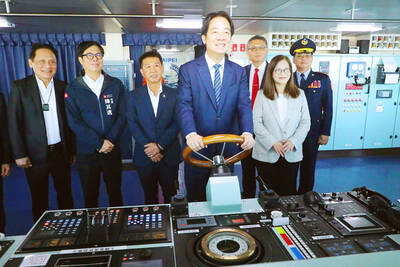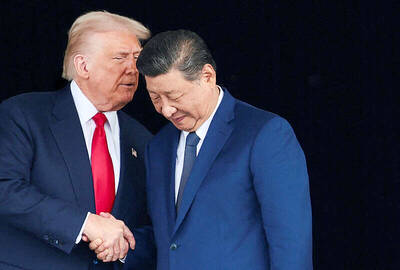A military source on Friday confirmed plans for the production of an upgraded version of the navy’s Tuo Chiang-class stealth corvette that is to incorporate expanded anti-aircraft capabilities.
The new vessel type is to be longer, wider and equipped with 3D radar systems and a ship-to-air version of the Tien Chien II (“Sky Sword”) guided missile system.
A total of 11 vessels are to be produced in three lots, for a total of 12 ships including the original Tuo Chiang-class corvette, the source said.

Photo courtesy of the Military News Agency
The navy plans to begin operating three of the new vessels and make design adjustments where needed before commissioning the subsequent two lots, the source said, adding that the first lot is scheduled to be completed by 2025 at a cost of NT$14.434 billion (US$471.68 million).
Navy contractors are to submit final designs by the end of this month, when final bidding for the contract is also to take place, the source said.
The displacement of the upgraded vessels is to increase by about 100 tonnes from the current model’s 567 tonnes. They are also being designed to reach a maximum speed of more than 30 knots (55.56kph), the source said.

Photo: Liu Hsin-de, Taipei Times
The class’ length is to be increased from 60.4m to 65m, while width is to increase from 14m to 15m and draft is to increase from 2.3m to 3m, the source said.
The size increases would result in ships of the upgraded class being able to carry more personnel, from the original vessel’s 41 crew to 53, with sleeping quarters to be adjusted to accommodate the additional personnel, the source said.
The decision to upgrade the Tuo Chiang-class corvette was based primarily on a need to improve its anti-aircraft capabilities, the source said, adding that the Tien Chien II missile and 3D radar systems would complement the current model’s Hsiung Feng II and Hsiung Feng III (“Brave Wind”) anti-ship missiles.
“The Hsiung Feng and Tien Chien missile systems can be combined in whatever configuration the mission calls for,” the source added.
The biggest visible change would be to the radar mast, which is to be larger on the upgraded vessels due to the 3D radar system, the source said.
The bridge on the new vessels would be larger than the original’s, with a closed tower-style mast containing the radar system fitted above, the source added.

CALL FOR SUPPORT: President William Lai called on lawmakers across party lines to ensure the livelihood of Taiwanese and that national security is protected President William Lai (賴清德) yesterday called for bipartisan support for Taiwan’s investment in self-defense capabilities at the christening and launch of two coast guard vessels at CSBC Corp, Taiwan’s (台灣國際造船) shipyard in Kaohsiung. The Taipei (台北) is the fourth and final ship of the Chiayi-class offshore patrol vessels, and the Siraya (西拉雅) is the Coast Guard Administration’s (CGA) first-ever ocean patrol vessel, the government said. The Taipei is the fourth and final ship of the Chiayi-class offshore patrol vessels with a displacement of about 4,000 tonnes, Lai said. This ship class was ordered as a result of former president Tsai Ing-wen’s (蔡英文) 2018

‘SECRETS’: While saying China would not attack during his presidency, Donald Trump declined to say how Washington would respond if Beijing were to take military action US President Donald Trump said that China would not take military action against Taiwan while he is president, as the Chinese leaders “know the consequences.” Trump made the statement during an interview on CBS’ 60 Minutes program that aired on Sunday, a few days after his meeting with Chinese President Xi Jinping (習近平) in South Korea. “He [Xi] has openly said, and his people have openly said at meetings, ‘we would never do anything while President Trump is president,’ because they know the consequences,” Trump said in the interview. However, he repeatedly declined to say exactly how Washington would respond in

WARFARE: All sectors of society should recognize, unite, and collectively resist and condemn Beijing’s cross-border suppression, MAC Minister Chiu Chui-cheng said The number of Taiwanese detained because of legal affairs by Chinese authorities has tripled this year, as Beijing intensified its intimidation and division of Taiwanese by combining lawfare and cognitive warfare, the Mainland Affairs Council (MAC) said yesterday. MAC Minister Chiu Chui-cheng (邱垂正) made the statement in response to questions by Democratic Progressive Party (DPP) Legislator Puma Shen (沈柏洋) about the government’s response to counter Chinese public opinion warfare, lawfare and psychological warfare. Shen said he is also being investigated by China for promoting “Taiwanese independence.” He was referring to a report published on Tuesday last week by China’s state-run Xinhua news agency,

‘ADDITIONAL CONDITION’: Taiwan will work with like-minded countries to protect its right to participate in next year’s meeting, the foreign ministry said The US will “continue to press China for security arrangements and protocols that safeguard all participants when attending APEC meetings in China,” a US Department of State spokesperson said yesterday, after Beijing suggested that members must adhere to its “one China principle” to participate. “The United States insists on the full and equal participation of all APEC member economies — including Taiwan — consistent with APEC’s guidelines, rules and established practice, as affirmed by China in its offer to host in 2026,” the unnamed spokesperson said in response to media queries about China putting a “one China” principle condition on Taiwan’s